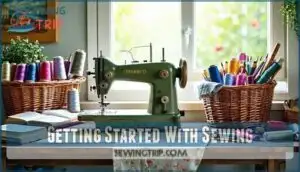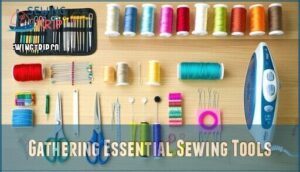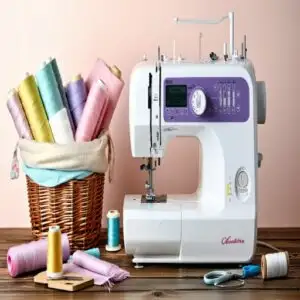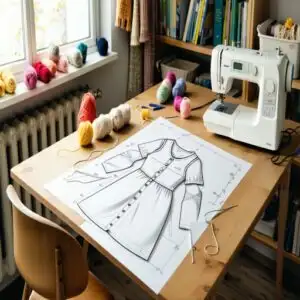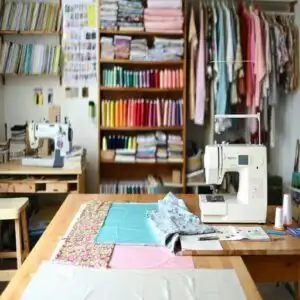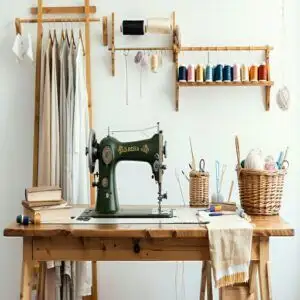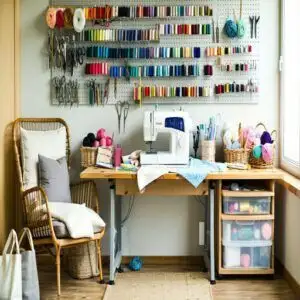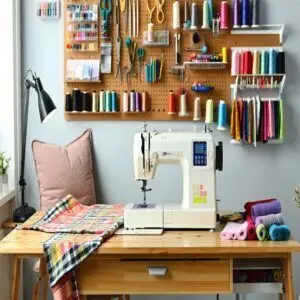This site is supported by our readers. We may earn a commission, at no cost to you, if you purchase through links.
 If you’re wondering how to start a sew, it’s easier than you think—just a stitch at a time!
If you’re wondering how to start a sew, it’s easier than you think—just a stitch at a time!
Set up a comfy sewing space and grab the basics: sharp fabric scissors, needles, pins, thread, and a simple sewing kit.
Pick beginner-friendly materials like cotton; it’s forgiving and won’t slip out of control.
Prewash the fabric to avoid surprises later, and practice straight stitches on scraps (you and your machine need some bonding time).
Start with a simple project like a pillowcase—no one will notice uneven seams when they’re napping!
Sewing’s all about patience, practice, and making something uniquely yours.
Ready?
Table Of Contents
Key Takeaways
- You’ll need essential tools to begin: sharp fabric scissors, needles, pins, thread, and a basic sewing kit – start with these fundamentals before investing in more specialized equipment.
- Choose beginner-friendly materials like cotton fabric, as it’s stable, easy to handle, and forgiving when you make mistakes while learning basic stitches.
- Start with simple projects like pillowcases or tote bags that have straight seams and clear guidelines – they’ll help you build confidence and master fundamental techniques.
- Practice basic stitches on scrap fabric first to understand thread tension, machine operation, and develop muscle memory before tackling actual projects.
Getting Started With Sewing
Starting your sewing journey is like stepping into a creative playground—fun, rewarding, and a tad messy at first (in the best way).
Set up a cozy Sewing Space to keep things organized and inviting.
Choose beginner-friendly fabrics like cotton; they won’t fight you like slippery silk might.
Got your fabric? Don’t skip prewashing—it avoids surprises later, like shrinking clothes for dolls.
Find simple Beginner Resources online for patterns, tutorials, and tips.
Trace your patterns carefully with fabric chalk; it’s your roadmap for success.
Learning to sew? Start with straight and zigzag stitches on scrap fabric—think of it like doodling to warm up.
To get started, understanding basic sewing techniques is essential for any beginner.
Don’t forget Sewing Safety—watch those fingers!
Step into a Sewing Community for laughs, support, and all the free advice you could dream of.
Keep stitching—you’ve got this!
Gathering Essential Sewing Tools
So, you’ve got the itch to sew—great! But what do you actually need to get going without overloading your cart (or budget)? Let’s break it down:
Start with a basic sewing kit. Grab sharp fabric scissors (trust me, they’re game-changers), a mix of sewing needles for everything from patching to embroidery, and pins to keep fabric in line before stitching. Add in some sewing threads—a few neutral tones and a pop of color for fun.
Next, stock up on handy extras, aka sewing notions: a pin cushion, a solid seam ripper (mistakes happen!), and a measuring tape. Don’t forget a sturdy iron—crispy seams are the secret sauce to pro-looking projects.
To get inspired, explore easy sewing projects that can help you create beautiful home decor items. Stash it all in a compact organizer. With these tools, you’re armed and ready for every stitch, snag, and sparkle your creative spirit dreams up.
Learning The Basics of Sewing Machines
Now that your tools are ready, let’s tackle sewing machine basics! First-time users, don’t sweat—it’s simpler than it seems.
Master bobbin management (your thread’s sidekick), adjust thread tension for smooth stitches, and explore fun stitch selection options. Keep your machine happy with regular machine maintenance—a little oil goes a long way! Understanding the sewing machine parts is essential for a successful sewing experience.
Try this:
- Test stitches on scrap fabric—it’s like a sewing playground.
- Watch free sewing tutorials online for clear, step-by-step tips.
- Experiment with different stitches to build confidence.
- Noisy machine? Clean it, it’s probably just cranky!
Choosing Your First Sewing Project
Picking your first sewing project is all about starting simple and building confidence.
Choose something easy that won’t make you want to hide your new sewing machine in the closet!
Selecting a Simple Pattern
Finding the right pattern is like picking your first dance partner—it sets the tone!
Stick with beginner-friendly sewing patterns.
- Choose simple patterns with straight seams and clear guides.
- Avoid designs needing intense measurements or tricky closures (zippers > buttons).
- Focus on comfort and ease, not perfection.
Understanding sewing pattern basics is essential for selecting the right project.
Pattern Choices become second nature as you learn to sew.
Keep exploring, start stitching, and embrace every mistake—it’s part of the magic!
Choosing The Right Fabric
So you’ve picked your pattern—now let’s talk fabric!
Beginners, stick with cotton fabric or linen fabric—they’re like the best trainers in a gym.
Fabrics with a stable texture, like cotton blends, are easy to control, wash, and sew.
When working with cotton fabric, understanding cotton fabric properties is essential for the best results.
Pay attention to Sewing Weights: does your project need something flowy or firm?
Here’s a quick helper table:
| Fabric Types | Texture | Care | Use | Sewing Level |
|---|---|---|---|---|
| Cotton Fabric | Smooth | Machine washable | Garments, bedding | Beginner |
| Linen Fabric | Textured | Machine washable | Summer clothes | Beginner |
| Flannel | Soft, fuzzy | Machine washable | Pajamas, blankets | Beginner |
| Polyester | Slightly silky | Easy care | Everyday clothing | Intermediate |
| Rayon | Light drape | Gentle wash | Dresses, curtains | Intermediate |
Pick Thread Colors that match or pop, and you’re ready!
Following Step-by-Step Instructions
When you follow a sewing guide, it’s like assembling a puzzle—each piece fits perfectly if you take it step by step.
Ready to start? Here’s your step-by-step guide:
- Master Pattern Reading: It’s your sewing GPS—study it like a treasure map.
- Prep Your Fabric: Cut carefully, iron wrinkles, and stay organized.
- Use Sewing Tutorials: Watch instructional videos or flip through step manuals.
- Stick to the Sewing Order: Each stitch builds the foundation—don’t skip ahead!
Mistakes? They’re part of the sewing steps education, not the end!
Sewing Techniques for Beginners
Getting the hang of basic sewing techniques is easier than you’d think—you just need a little patience and the right tips.
From threading your needle to perfecting your stitches, these small but essential skills will have you sewing like a pro in no time.
Thread Selection and Handling
How do you make sewing threads work their magic? Start by nailing thread types that match your fabric. Go for cotton threads with natural fibers or explore polyester for flexibility. Balance your tension—keep it tight, but not grumpy.
Don’t skip old-school color matching tricks; the right hue hides mistakes! Store threads like fine wine—cool, dry, and away from sunlight. When working with cotton threads, understanding cotton thread options is essential for the best results.
- Experiment with yarn weights.
- Use thread conditioners for ease.
- Prep multiple bobbins beforehand.
- Avoid discount disasters.
- Test tension regularly.
Stitching Basics
Ready to stitch? Thread control is the first step—thread your needle (a needle threader’s a lifesaver).
Master the basics like the running stitch for seams or backstitch for strength.
Keep your thread tension smooth. Practice sewing straight lines on scrap fabric to develop consistency.
Play with different stitching patterns, fabrics, and needles until it feels as natural as breathing.
Finishing Techniques
Seal your sewing projects with professional flair using these finishing techniques.
- Secure seams: Use French seams or edge-stitching to hide raw edges for a polished look.
- Perfect hems: Try hemming techniques like blind hems or binding methods for clean, neat edges.
- Press and trim: Press seams flat with an iron, and snip stray threads for tidy sewing finishes.
These tricks boost every stitch!
Tips for Beginner Sewers
Confidence is built one stitch at a time, so don’t stress the little stuff.
Beginner sewing is all about learning as you go.
Think of mistakes as your free teachers!
Before diving into your first masterpiece, here are four essential tips to keep you on track:
- Practice Your Stitches: Grab scrap fabric and perfect those beginner techniques. It’s like doodling, but with thread!
- Iron Everything: Wrinkled fabric creates chaos. An iron is your secret weapon for polished results.
- Stay Sharp: Scissors, marking tools, and patterns—precision guarantees sewing success. Trace and cut like a pro.
- Plan Ahead: Gather tools and materials beforehand to avoid frantic searches mid-project.
Embrace the journey, join a sewing community, and discover creative freedom.
Sharing Your Sewing Journey
Sharing your sewing journey adds excitement to your progress.
Snap pictures as you work—fabric picks, early stitches, and those "oops" moments too.
Post them in sewing communities, online forums, or blogs, and share tips while soaking up feedback.
Social media is perfect for crafting a virtual "sewing diary."
Add captions with lessons learned or funny mishaps.
Engaging with others sparks inspiration and connections.
As you reflect on your experiences, consider the value of sewing lessons learned in shaping your skills and creativity.
Check out this guide for sharing ideas:
| Platform | What to Share | Benefits | Fun Tips | Audience Style |
|---|---|---|---|---|
| Facebook Groups | Progress photos | Feedback & support | Ask for advice on tricky details | Beginners & Pros |
| Final creations | Inspiration | Use hashtags like #SewingForBeginners | Visual Creatives | |
| Tutorials | Build ideas archive | Pin creative sewing boards | DIY Enthusiasts | |
| Sewing Blogs | Full journey posts | Share detailed guides | Add humor and personal touch | Readers & Learners |
| Reddit Threads | "Behind the seams" tips | Honest critiques | Start sewing Q&A threads | Sewing Nerds |
Turn those stitches into stories, and your “learn to sew” adventure might inspire someone else’s first thread!
How to Start Learning to Sew
Learning to sew feels like opening a treasure chest of creativity.
Whether you’re sewing for fun or function, starting simple is key.
Think of your first projects as training wheels—try sewing a basic tote bag, pillowcase, or even a fabric bookmark.
These fun wins build your Sewing Motivation while teaching the basics.
Stick to medium-weight cotton fabric—it’s beginner-friendly and doesn’t slip around like a playful toddler at bedtime.
Mistakes? Expect a few!
Each wobbly stitch means progress.
Here’s a short how-to-sew guide to kick things off:
- Pick Straight-Sew Patterns: Tote bags or drawstring pouches work great.
- Choose Easy Fabrics: Cotton blends are your BFF here.
- Use Beginner Resources: Tutorials and sewing classes are gold.
- Practice Confidence: Patience grows skills—and crooked stitches tell fun stories.
Keep stitching—you’re discovering a new world!
Frequently Asked Questions (FAQs)
What Fabrics and Materials Are Best for Beginners?
Like a smooth sail on calm waters, you’ll want to begin with cotton fabrics.
They’re easy to work with and forgiving.
Grab medium-weight cotton, quilting cotton, or muslin for your first projects.
How Do I Thread a Sewing Needle?
Hold the thread at a 45-degree angle and push it through the needle’s eye.
If you’re struggling, wet the thread’s tip or use a needle threader.
Double-check it’s secure before starting.
What Are Some Common Mistakes Beginners Make?
You’ll often skip measuring twice, rush through instructions, and forget to change needles regularly.
Watch your tension settings, avoid cheap thread, and don’t force thick fabrics through your machine without proper tools.
Where Can I Find Sewing Patterns for Beginners?
You’ll discover free patterns on Pinterest, crafting blogs, and websites like Mood Fabrics and AllFreeSewing.
These sites offer thousands of beginner-friendly projects from pillowcases to simple clothing pieces, with clear step-by-step instructions.
How Do I Finish Seams Properly?
You’d think seams were simple straight lines, but here’s your pro secret: press edges open, finish with zigzag or serger for ready-to-wear polish, and clip curved seams for smooth curves.
How do you start the first stitch in sewing?
Thread your needle and tie a secure knot at the end.
Place fabric under the presser foot, lower it, and gently press the foot pedal while guiding the material smoothly forward to begin your stitch.
How to start sewing from scratch?
Begin your sewing journey with simple supplies: a needle, thread, and fabric.
You’ll want basic scissors and pins too.
Practice straight stitches on scrap fabric, then move to easy projects like pillowcases.
What is the first thing a beginner should sew?
You’ll want to try a simple straight-line project like a pillowcase or tote bag first.
These classics help you practice basic stitches and boost your confidence without feeling overwhelmed by complicated patterns.
How do I start sewing as a hobby?
Just as a bird builds its nest stick by stick, you’ll build your sewing skills.
Grab a basic sewing kit, pick simple projects like pillowcases, and join online communities.
You’ll master it step by step.
How to start sewing?
Get a simple sewing machine, basic supplies like needles and thread.
You’ll want to practice straight stitches on scrap fabric first.
Once you’re comfortable, try small projects like pillowcases or tote bags.
Conclusion
Now that you’ve got the lay of the land, you’re ready to start a sew with confidence!
Remember, every expert seamster started exactly where you are.
Take it slow, embrace the learning curve, and don’t sweat the small mistakes—they’re part of your unique creative journey.
Whether you’re stitching pillowcases or dreaming of designer dresses, focus on enjoying each step.
Keep your tools organized, your machine maintained, and your creativity flowing.
You’ve got this!

